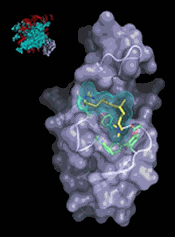A team of Mayo Clinic researchers has uncovered a key step in the molecular pathway of repairing DNA double-strand breaks. The studies were carried out using the 19-ID beamline (SBC-CAT) at the Advanced Photon Source (APS, Argonne) and the X12-C beamline at the National Synchrotron Light Source (NSLS, Brookhaven National Laboratory). Both the APS and the NSLS are funded by the U.S. Department of Energy’s Office of Basic Energy Sciences.
Double-strand breaks in DNA can result from external agents such as ultraviolet (UV) radiation or mutagenic chemicals. If left unrepaired, a single DNA double-strand break can lead to cell death or cancer. As a consequence, cells have evolved elaborate machinery made of proteins that detect and repair these DNA lesions. A basic understanding of how this DNA repair machinery functions is important to finding ways of correcting the DNA double-strand break repair process when it goes awry. Studying DNA repair at the atomic level is necessary to understand the process.
The Mayo research team showed that 53BP1 (a human protein essential for repairing DNA double-strand breaks) is recruited to the sites of DNA damage by direct interaction with histone H4, a protein constituent of the DNA packaging structure called chromatin.
The team discovered that 53BP1 only recognizes one specific form of histone H4 in which two methyl groups are attached to a lysine amino acid (i.e., dimethylated histone H4). 53BP1 does not interact with histone H4 when the lysine has three methyl groups. To understand the origin of the high specificity of 53BP1 for dimethylated histone H4, the Mayo team deciphered the detailed atomic structure of 53BP1 in complex with histone H4 by using x-ray crystallography and nuclear magnetic resonance spectroscopy.
It was known from previous studies in fission yeast that histone H4 and Crb2 (the protein counterpart of 53BP1 in fission yeast) are important components of the DNA repair machinery. This new work shows that this also is true in humans and that direct binding of 53BP1 to histone H4 is necessary to bring 53BP1 near the damaged DNA. In a similar fashion, the researchers also demonstrated that Crb2 directly interacts with histone H4.
Contact: Junjie Chen ( [email protected]); Georges Mer ([email protected])
See: Maria Victoria Botuyan, Joseph Lee, Irene M. Ward, Ja-Eun Kim, James R. Thompson, Junjie Chen, and Georges Mer, "Structural Basis for the Methylation State-Specific Recognition of Histone H4-K20 by 53BP1 and Crb2 in DNA Repair," Cell 127, 1361 (29 December 2006).
The original version of this Mayo Clinic press release can be found at: https://newsnetwork.mayoclinic.org/
The research was supported by the National Institutes of Health and the Mayo Clinic.
Use of the Advanced Photon Source was supported by the US Department of Energy, Office of Science, Office of Basic Energy Sciences, under Contract No. W-31-109-ENG-38.
Argonne is a U.S. Department of Energy laboratory managed by UChicago Argonne, LLC

